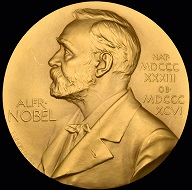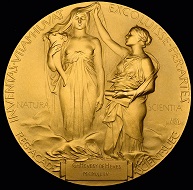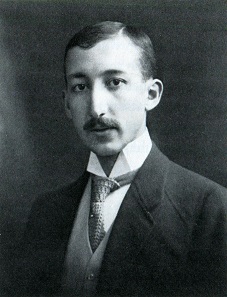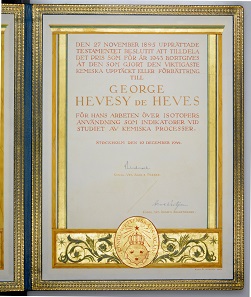November 16, 2017 – The magnificent gold Nobel prize medal for chemistry, together with three further significant medals awarded to the renowned Hungarian scientist George Charles de Hevesy are to be auctioned by specialist auctioneers Morton & Eden in London on Thursday November 23, 2017. The group is estimated to fetch £120,000 to £150,000 (lot 77). Online bidding is possible through Numisbids and The Saleroom.
Lot 77 of upcoming Morten & Eden Auction: De Hevesy’s gold Nobel prize medal.
George Charles de Hevesy (1885-1966) is credited with being the founder of radio analytical chemistry. He was joint discover of the element Hafnium in 1922 and he developed the use of radioactive isotopes as tracers. It was for his considerable scientific achievements that Hevesy was awarded the Nobel Prize, which he received in 1944, at the same time accepting the Nobel Institute’s offer of Swedish citizenship. The official citation for his prize used the now-familiar terms ‘isotopes’ and ‘tracers’, which had not even been coined when Hevesy embarked on his career on joining Ernest Rutherford in Manchester in 1911.
Photograph of young de Hevesy.
Before himself becoming a Nobel laureate Hevesy concealed two Nobel medals from the Nazis by the remarkable expedient of dissolving them in a solution of ‘aqua regia’. Under the Third Reich in Germany private ownership of gold was declared illegal and could incur the death penalty. The medals were those of the German physicists Max von Laue and James Franck, Nobel laureates in 1914 and 1925 respectively, whose personally-named and potentially incriminating gold medals were stored at the Bohr Institute in Copenhagen.
Hevesy, who was working there in the summer of 1940 when the Germans invaded Denmark, had to quickly think how to hide the gold medals. After rejecting the idea of burying them, he simply made them disappear by dissolving them in ‘aqua regia’, a mixture of nitric and hydrochloric acid. The flask containing its inconspicuous looking solution sat innocently on a shelf and stayed there undisturbed until the end of the War. Hevesy was then able to recover the gold by reversing the chemical process and subsequently return the reconstituted metal to the Nobel Foundation where it was duly used to make restrikes of the two medals. These were then re-awarded to both their original recipients in 1952.
The official Nobel Prize Certificate of De Hevesny.
David Kirk of Morton & Eden said: “George de Hevesy’s work and achievements have led, in particular, to enormous advances in radiobiology, medical research and clinical diagnosis, including XRF and not surprisingly he was recognised with numerous accolades and honours during his lifetime. The medals have remained in Hevesy’s family until now and it is a huge privilege to be able offer these medals to be appreciated by a wider audience.”
Also included with Hevesy’s Nobel Medal for Chemistry is the Royal Society’s silver-gilt Copley medal designed by Mary Gillick and awarded in 1949; the Royal College of Physician’s Baly Medal in silver by J.S. and A.B. Wyon, named and dated 1951; and the large gold Atoms for Peace Award by the Medallic Art Co., New York dated 1958.
For more information visit the website of Morten & Eden where you can also find a pdf containing the material of this auction.
Further biographical details of George de Hevesy can be found on The Official Web Site of the Nobel Prize.
And for an easily understandable summary of de Hevesy’s achievements in chemistry, access the Stockholm University website.








